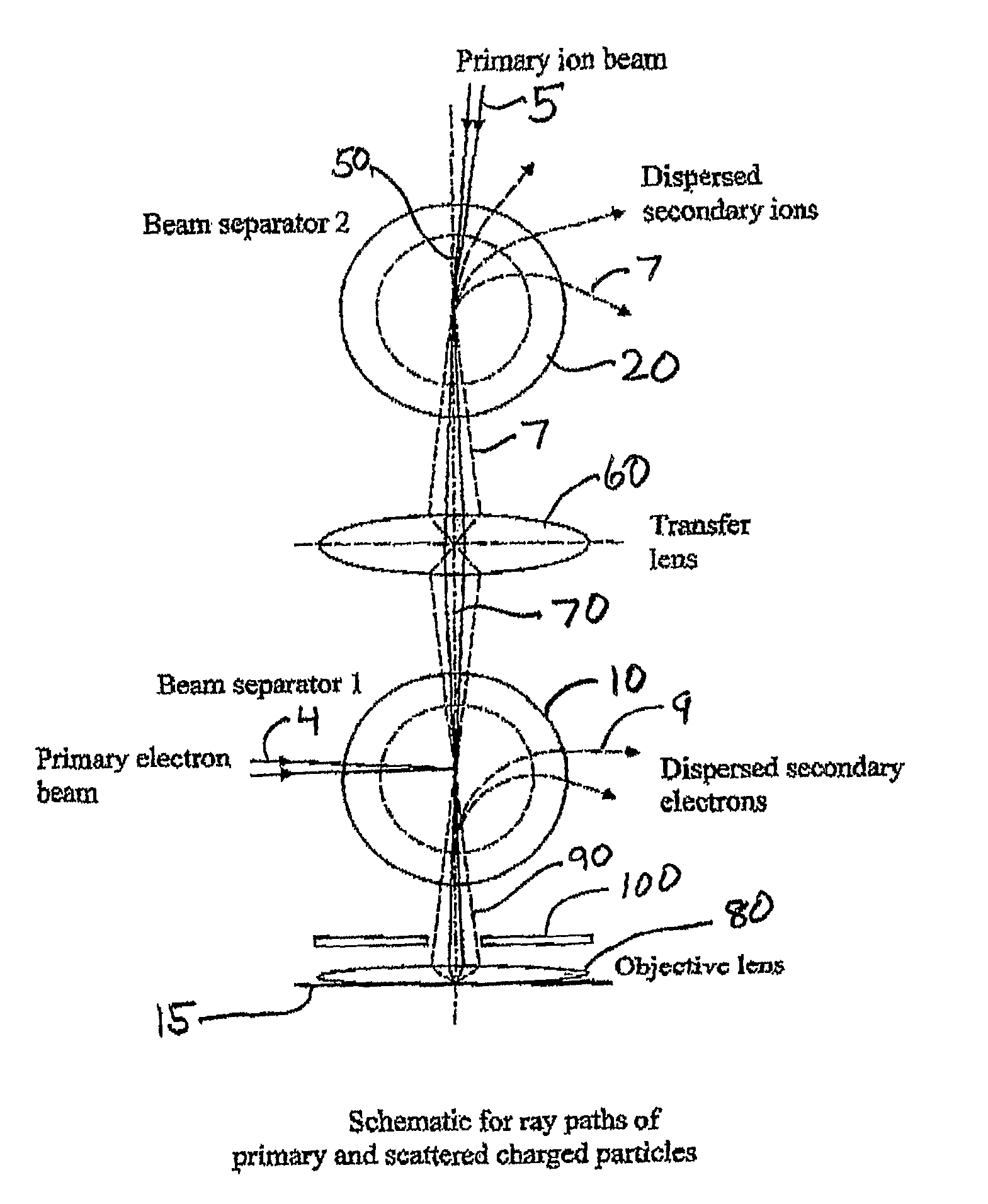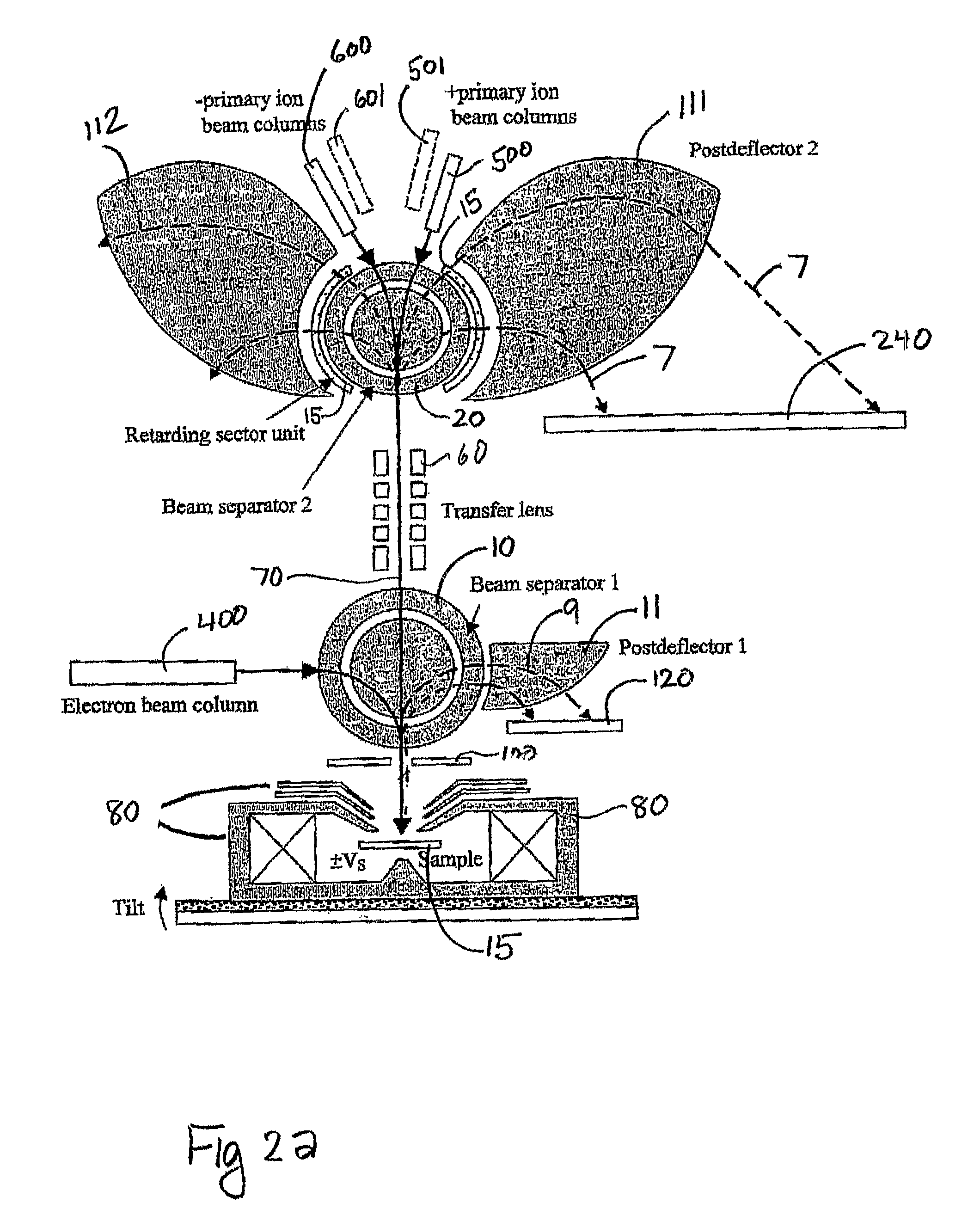It is a first object of this invention to provide a multi-beam charged particle instrument that can simultaneously focus electrons and a variety of ions on a material sample.
It is a fifth object of the present invention to provide such an instrument wherein an electron beam and an ion beam can be operated in parallel to provide a highly dispersive mass / energy spectrometer, providing, thereby, far more advantages and capabilities than a separately operating SEM and mass spectrometer.
To accommodate both types of charged particles (electrons and ions) here are two beam separators, one for electron beams (beam separator 1 (10)) and one for ion beams (beam separator 2 (20)). These beam separators consist of two circular magnetic sector plates (see discussion below for FIG. 3), which are able to deflect a charged particle beam while at the same time focus it like a round lens, a feature known as stigmatic focusing (see: M. Osterberg and A. Khursheed, “Simulation of magnetic deflector aberration properties for low energy microscopy”, Nucl. Instrum. and Method in Phys. Res., A 555 (2005), p 20-30). The central concept underlying the instrument is to use beam separators of this kind to bend both primary ion (5) and electron (4) beams incident on the material target (15) and to then act to disperse subsequent scattered ions / electrons that travel in the opposite direction (7), (9). A beam separator used in this dual way constitutes the first stage of an energy / mass spectrometer. A similar concept, albeit one that is much narrower in scope and generality, has been applied to an electron beam only and has previously been incorporated by the author in an SEM design that can incorporate a parallel energy spectrometer for the scattered electrons (see US Published Application 2006 / 0060782A1 cited above and fully incorporated herein by reference). In the present invention, two beam separators are shown to be capable of operation singly and in parallel so that the same concept that is applicable to electrons can also be applied to ions and to ions and electrons in combination, making it possible to design a versatile parallel mass spectrometer that can be used alongside an energy spectrometer for electrons.
To minimize deflection aberrations, each charged particle primary beam (5), (4), needs to be pre-focused so that its incoming rays are directed towards the centre of the beam separator. A primary ion beam (5), as shown in FIG. 1, is first directed towards the centre of beam separator 2 (20). The ion beam undergoes a deflection (shown as a bend in the path (50)) before traveling into an electrostatic transfer lens (60), which provides suitable pre-focusing so that it converges towards the centre of beam separator 1 (10). Beam separator 1 (10) is designed to deflect an electron primary beam down on to the same optical axis (70) as the primary ion beam. There will be a very small tendency of beam separator 1 to deflect the primary ion beam also, but because it is designed to deflect electrons, this effect will be very small and can be compensated by suitably tilting the objective lens / specimen so that the primary ion beam strikes it perpendicularly (not indicated in FIG. 1, but shown schematically in FIG. 2a). After traversing beam separator 1, both the primary ion and electron beams are focused on to the specimen by a combined electrostatic / magnetic field objective lens (80). A second embodiment of the present invention, described in FIG. 2b, will disclose a mechanism for eliminating the necessity of tilting the sample. Specimen.
The objective lens can be designed to focus the scattered secondary ions / electrons (90) from the sample surface to a point around the centre of beam separator 1, without greatly affecting the primary ion / electron beam optics. An aperture (100) placed at the top of the objective lens is used to limit the energy and angular spread of transmitted secondary ions. The scattered electrons (90) are subsequently dispersed by beam separator 1, and their energy spectrum can be captured in parallel by a multi-channel electron detector (120). The transfer lens (60) can be designed to direct. scattered ions towards the centre of beam separator 2 (20), without greatly affecting the primary ion beam, so that they will be dispersed, according to their energies and charge-to-mass ratios. Beam separator 2, therefore, forms the first stage of a highly dispersive mass spectrometer.
 Login to View More
Login to View More  Login to View More
Login to View More 


